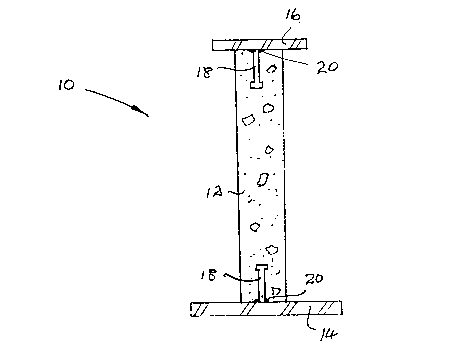Some of the information on this Web page has been provided by external sources. The Government of Canada is not responsible for the accuracy, reliability or currency of the information supplied by external sources. Users wishing to rely upon this information should consult directly with the source of the information. Content provided by external sources is not subject to official languages, privacy and accessibility requirements.
Any discrepancies in the text and image of the Claims and Abstract are due to differing posting times. Text of the Claims and Abstract are posted:
| (12) Patent: | (11) CA 2023198 |
|---|---|
| (54) English Title: | COMPOSITE GIRDER CONSTRUCTION AND METHOD OF MAKING SAME |
| (54) French Title: | POUTRELLE EN MATERIAU COMPOSITE ET METHODE DE FABRICATION DE LADITE POUTRELLE |
| Status: | Term Expired - Post Grant Beyond Limit |
| (51) International Patent Classification (IPC): |
|
|---|---|
| (72) Inventors : |
|
| (73) Owners : |
|
| (71) Applicants : | |
| (74) Agent: | BORDEN LADNER GERVAIS LLP |
| (74) Associate agent: | |
| (45) Issued: | 1995-10-03 |
| (22) Filed Date: | 1990-08-13 |
| (41) Open to Public Inspection: | 1992-01-27 |
| Examination requested: | 1992-12-07 |
| Availability of licence: | N/A |
| Dedicated to the Public: | N/A |
| (25) Language of filing: | English |
| Patent Cooperation Treaty (PCT): | No |
|---|
| (30) Application Priority Data: | ||||||
|---|---|---|---|---|---|---|
|
A girder comprises a web of reinforced concrete
with steel plates attached to opposite sides of the web to
form flanges which project from the web. The steel plates
are attached to the web by means of studs. The web is
cast in position between the plates to embed the studs
therein. The girder is used in the construction of
bridges.
Note: Claims are shown in the official language in which they were submitted.
Note: Descriptions are shown in the official language in which they were submitted.

2024-08-01:As part of the Next Generation Patents (NGP) transition, the Canadian Patents Database (CPD) now contains a more detailed Event History, which replicates the Event Log of our new back-office solution.
Please note that "Inactive:" events refers to events no longer in use in our new back-office solution.
For a clearer understanding of the status of the application/patent presented on this page, the site Disclaimer , as well as the definitions for Patent , Event History , Maintenance Fee and Payment History should be consulted.
| Description | Date |
|---|---|
| Inactive: Expired (new Act pat) | 2010-08-13 |
| Inactive: Office letter | 2006-12-05 |
| Inactive: Payment - Insufficient fee | 2006-11-14 |
| Inactive: Office letter | 2006-10-12 |
| Inactive: Payment - Insufficient fee | 2006-10-11 |
| Inactive: Payment - Insufficient fee | 2006-08-21 |
| Inactive: IPC from MCD | 2006-03-11 |
| Inactive: IPC from MCD | 2006-03-11 |
| Inactive: IPC from MCD | 2006-03-11 |
| Inactive: Late MF processed | 2005-01-25 |
| Letter Sent | 2004-08-16 |
| Inactive: Entity size changed | 2003-08-06 |
| Inactive: Late MF processed | 2001-09-27 |
| Letter Sent | 2001-08-13 |
| Grant by Issuance | 1995-10-03 |
| All Requirements for Examination Determined Compliant | 1992-12-07 |
| Request for Examination Requirements Determined Compliant | 1992-12-07 |
| Application Published (Open to Public Inspection) | 1992-01-27 |
There is no abandonment history.
The last payment was received on
Note : If the full payment has not been received on or before the date indicated, a further fee may be required which may be one of the following
Please refer to the CIPO Patent Fees web page to see all current fee amounts.
| Fee Type | Anniversary Year | Due Date | Paid Date |
|---|---|---|---|
| MF (patent, 8th anniv.) - small | 1998-08-13 | 1998-05-28 | |
| MF (patent, 9th anniv.) - small | 1999-08-13 | 1999-07-27 | |
| MF (patent, 10th anniv.) - small | 2000-08-14 | 2000-06-30 | |
| Reversal of deemed expiry | 2004-08-13 | 2001-09-27 | |
| MF (patent, 11th anniv.) - small | 2001-08-13 | 2001-09-27 | |
| Reversal of deemed expiry | 2004-08-13 | 2002-06-20 | |
| MF (patent, 12th anniv.) - small | 2002-08-13 | 2002-06-20 | |
| MF (patent, 13th anniv.) - standard | 2003-08-13 | 2003-07-11 | |
| MF (patent, 14th anniv.) - standard | 2004-08-13 | 2005-01-25 | |
| Reversal of deemed expiry | 2004-08-13 | 2005-01-25 | |
| MF (patent, 15th anniv.) - standard | 2005-08-15 | 2005-07-28 | |
| MF (patent, 16th anniv.) - standard | 2006-08-14 | 2006-07-26 | |
| 2007-01-14 | 2006-10-19 | ||
| MF (patent, 17th anniv.) - standard | 2007-08-13 | 2007-08-09 | |
| MF (patent, 18th anniv.) - standard | 2008-08-13 | 2008-08-08 | |
| MF (patent, 19th anniv.) - standard | 2009-08-13 | 2009-08-06 | |
| MF (application, 2nd anniv.) - small | 02 | 1992-08-13 |
Note: Records showing the ownership history in alphabetical order.
| Current Owners on Record |
|---|
| 506275 B.C. LTD. |
| Past Owners on Record |
|---|
| NICHOLAS J. EUSTACE |